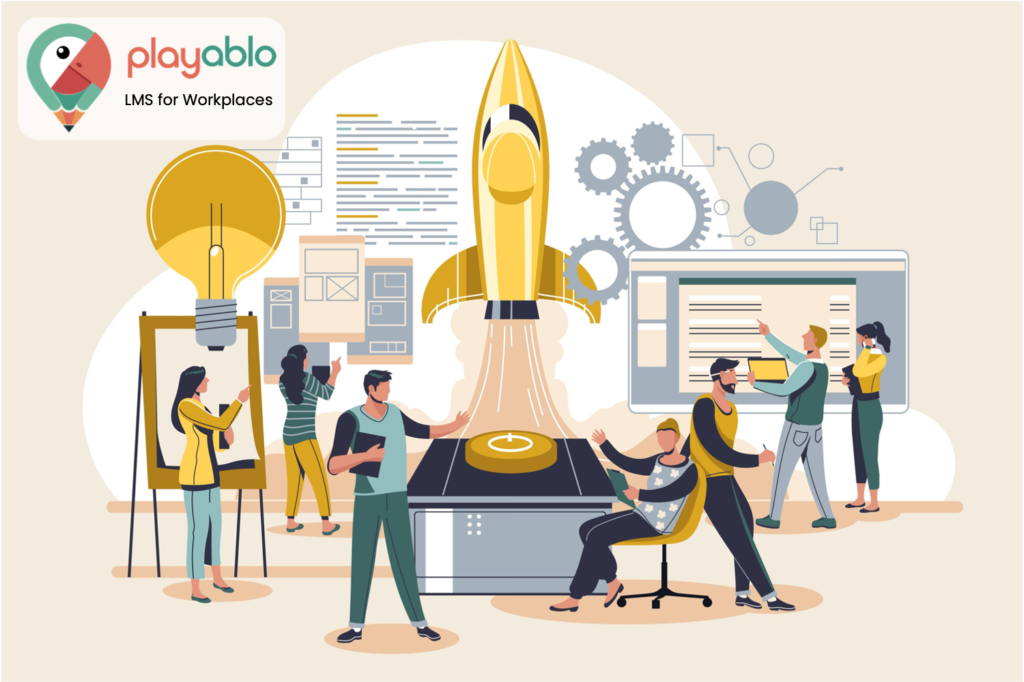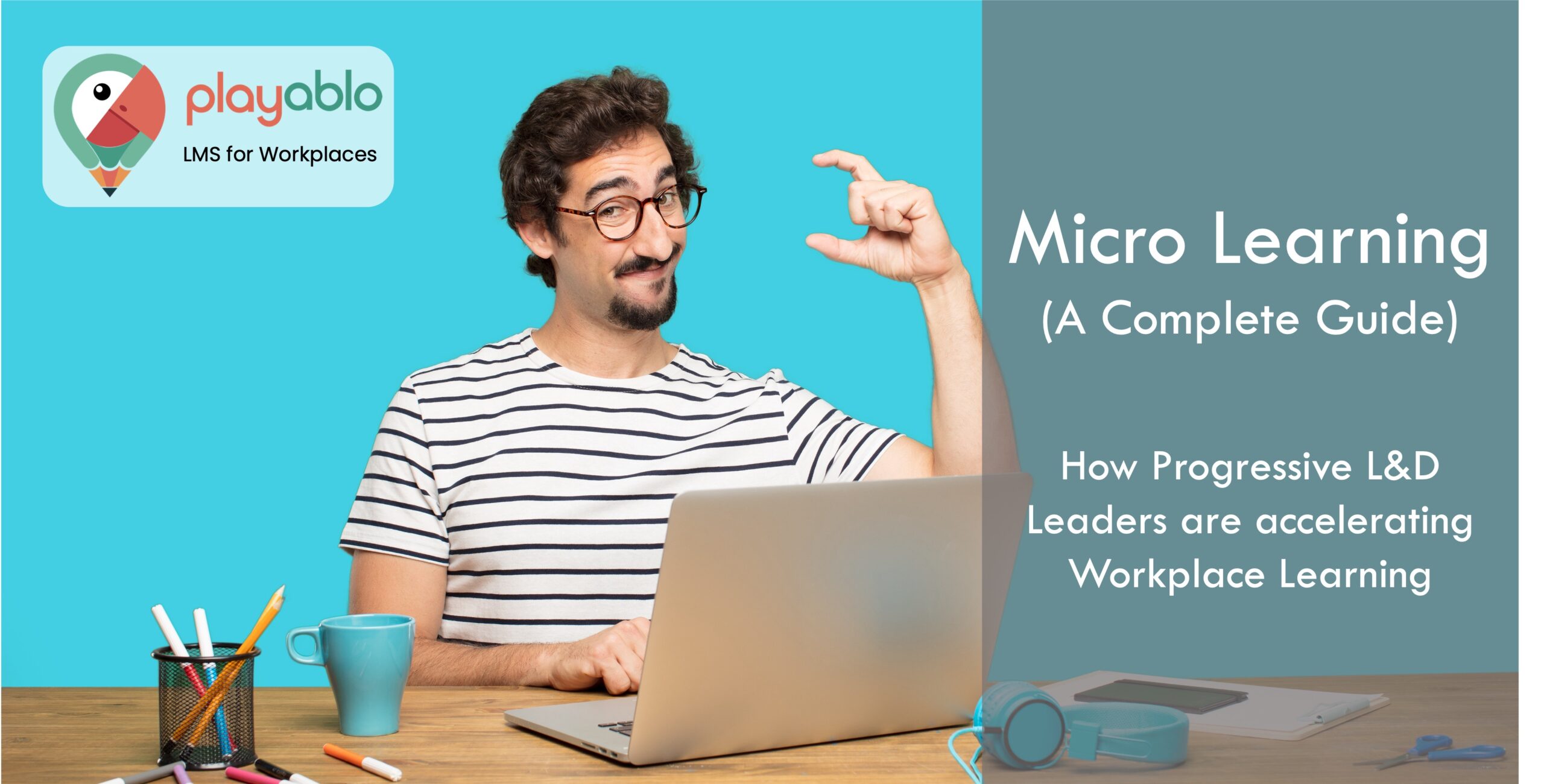A bite-sized approach is a perfect answer when your corporate training modules are too challenging to digest and overwhelm your learners. To discover more about what is microlearning and how you can use it to improve training engagement and knowledge retention, read the rest of our post.
Table of Contents
What Is Meant By Microlearning?
Microlearning is a powerful tool. Compared to standard eLearning, it is more engaging, less time-consuming, and less expensive to generate high ROI. While it isn’t the right choice for every type of training, it is surprisingly effective for corporate and workplace training.
By the end of this article, you’ll know what is microlearning, its traits, and how to utilize it in your training. Let’s begin!
What is Microlearning? Its Definition

While there is no official “micro learning meaning,” all bite-sized training has one thing in common: Concise, small learning units or short-term learning activities can be used to enable quick delivery of learning content.
Micro-training provides learners with small bursts of knowledge to study at their preferred pace and place. Content can take numerous forms, from text to fully interactive multimedia, but it must always be concise. That being said, let’s give you some instances of the different types of microlearning:
Some Micro Training Examples
- Short texts in the form of phrases or brief paragraphs
- Photos and illustrations
- Short video clips
- Audio clips in the form of short snippets of speech or music
- Quizzes and tests
- Gamified elements
It’s worth noting at this point that not all micro-learning apps support all of these content kinds. Check with your e-learning provider to see if the formats you want are supported.
Many people link micro-learning with video, which is a popular and frequently effective method of doing so. However, video is not the only feasible form of microlearning. Examples are self-paced e-learning, games, blogs, job aids, podcasts, infographics, and other visualizations. Professionals in talent development should choose the type of media most fit for their scenario and learning needs.
Read More: [Infographic] A Short History of Corporate L&D
One can answer ‘What is microlearning’ in a variety of ways. According to research, talent development professionals believe that 13 minutes is the maximum length of time for something to be termed microlearning. The ideal length of a micro-learning segment is 10 minutes, with portions between two and five minutes being the most successful.

While knowing the optimum time frame for classifying a training session as microlearning is helpful, many experts say it should not be limited merely to a specific time frame. Instead, it should be as long as it is necessary — no more, no less. Microlearning should concentrate on what is needed to know rather than what is good to know knowledge.
Read More: How To Counter the Forgetting Curve Using Microlearning
Your strategy should cover one or two learning objectives in each microlearning session. It’s also crucial to make sure that the learner can meet the learning goal through microlearnings. If extra time is needed to complete the objective, the course designer should not force-fit the content into microlearning chunks.
Why Is Microlearning Popular?
Even while bite-sized training has grown in popularity over the last two years, it has a long history predating computers’ invention. When it came into contact with the modern smartphone, though, it took off. So much so that the most popular microlearning platforms resemble a cross between Twitter and Instagram but for education.
Micro-learning is a near-perfect training paradigm in this day of hectic schedules and short attention spans. Organizations today are utilizing it for a variety of training needs. Employee onboarding, compliance training, and skills training are just a few instances of its usage in the real world.
Read More: High-Impact Employee Onboarding and Induction Training
Ad: PlayAblo’s Enterprise-Grade Micro-Learning platform is built for the corporate learner. Micro-learning, along with assessments and gamification features, ensures learning outcome measurement along with sustained engagement.
Find out more and request a custom demo!
How Does Microlearning Work?

The notion of acquiring abilities such as a language or a musical instrument in little, repeating chunks has long been recognized as a practical learning technique. Micro-learning is increasingly being proven to be a valuable technique for workplace learning and performance. According to studies, learners learn best and are more likely to remember what they learn when they can digest knowledge in tiny, manageable bits instead of a longer, more concentrated time frame.
Read More: Accelerate Compliance Training Adoption Using Micro-Learning!
Micro-learning is a type of teaching that is frequently technology-based or technology-enhanced. This scientifically validated method has only been around since the early 2000s when computers and the Internet opened up new possibilities for assisting students. Learners can now access micro-learning segments on the fly, thanks to the advancement of mobile technologies.
Read More: 8 Factors to Consider Before Choosing a Micro-Learning LMS
The learner can utilize it as performance assistance, with the learner accessing the segment only when they need it while performing a highly complex or infrequently performed activity. Micro-learning can also help with longer-term learning. Learners may, for example, attend a half-day in-person training and then access microlearning portions containing crucial subjects at a later time if they need a refresher.
Why Microlearning Is the Future: Its Top 7 Top Benefits

1. Consumes Less Time
Shorter course delivery times result from fewer items to write. In an hour, you may create a course with dozens of lessons using microlearning. This approach enables you to respond more quickly to shifting company objectives and new training requirements.
2. Is Less Expensive
Producing a microlearning course is also far less expensive. It necessitates fewer resources and instructors. To develop your content, you don’t even need any special microlearning tools. A standard LMS content editor would suffice. However, a specialist microlearning-based platform like PlayAblo will make the process much easier.
Read More: Micro-learning for Super-efficient Workplace Training
3. Offers Flexibility
Micro-learning courses can cover every topic covered by regular eLearning courses but in a bite-sized format. You can develop courses that provide a general overview of a subject or cover more advanced topics.
4. Leads to Higher Engagement Quotients
Micro-training is the most engaging technique of training delivery. When compared to the “serious study” vibe of traditional training, it feels like browsing your favorite social app on your smartphone.
5. Promotes Higher Information Retention
According to research, you retain information much better when you study it frequently and return it when you are on the verge of forgetting it. Because micro-learning units are small, self-contained, and easy to return to, they are ideal for such repetitive study.
6. Generates Better Business Results
Micro-learning is an ideal tool for businesses since it takes minimal inputs to produce maximal outputs. After all, the Pareto Principle should define your business strategy. According to Pareto’s Principle, 20% of efforts result in 80% of outcomes.
Traditional training approaches are time-consuming since data is spread all over the place. The amount of information that is transmitted in a single session is mind-boggling. Learners tend to skim through the material. The needs of today’s audience dictate the creation of micro-learning. As a result, it is the ideal option for a lifestyle that is rich in information.
Also, micro-learning cuts the time and expense of training in half, resulting in a higher return on training investments.
Read More: Calculating ROI on LMS Investment
7. Can Be Mobile-optimized
Micro-learning entails focusing on a particular subject at a time. Trainees can easily access these small training modules on their cellphones at any time, at the precise moment of need.
Furthermore, nearly 70% of the world’s population uses mobile phones today. In comparison to traditional, desktop-based sessions, bite-sized learning is better suitable for corporations.
What Are the Challenges of Implementing Microlearning?

We can’t simply compare microlearning to traditional eLearning and say it’s better or worse. It all depends on the topic at hand. However, in general:
1. Not Appropriate For Complex Concepts
Microlearning units are fantastic for conveying simple information, but they aren’t always ideal for more complicated subjects. It’s still conceivable, but it’ll take more work. You’ll need to break down the concept into small sections, for example. On the other hand, a bite-sized course is a terrific method to get a high-level overview of a subject.
2. Not Designed For Extensive Training
Microlearning might not be the best technique to choose if you have a subject that demands in-depth study. For example, you can use it to learn conversational German, but not to study German literature. Even so, in many circumstances, particularly in business training, a brief, self-contained course is all that is required.
What Tools Are Used for Microlearning?

In comparison to regular courses, microlearning courses are easy to start and finish. To get it correctly, you’ll still need to follow a few best practices:
1. Organizational Fit
Determine if it is appropriate for your Company. Microlearning is generally not for you if your subject is complex, requires in-depth study, or requires in-person teaching. Nonetheless, it might be a suitable fit as a supplement to other training methods.
2. Minimal Content
Don’t merely copy and paste sections of your standard eLearning course into a microlearning module and call it a day. Write concise, targeted text that encapsulates the essence of what you’re attempting to convey.
Read More: Your Go-to Guide to Convert PPT to Mobile Learning
3. Multimedia Content
Your students will become bored if you only give them a text. To maintain their attention, include relevant multimedia assets like movies, images, graphics, and animations. Carefully select the multimedia. It should add to your topic rather than make it look beautiful.
4. Gamification Elements
Add a few gamification features to your classes if your microlearning platform enables it. When combined with a mobile-based microlearning experience, gamification, the not-so-secret engagement weapon of traditional eLearning, becomes even more engaging.
Ad: PlayAblo’s Enterprise-Grade Micro-Learning platform is built for the corporate learner. Micro-learning, along with assessments and gamification features, ensures learning outcome measurement along with sustained engagement.
Find out more and request a custom demo!
Read More: Impact of Gamification in Corporate Learning
5. Micro-Assessments
Microlearning pairs nicely with micro-assessments, as you would have guessed. To ensure that your learners are progressing toward their training objectives, use small tests and short quizzes.
Read More: eLearning Assessments | Best Practices to Get Them Right!
6. Length of Microlearning Sessions
Microlearning should be as long as it is necessary, not limited to a specific duration.
7. Leaders’ Support
Holding learners accountable is a major roadblock to effective learning. Microlearning is frequently misunderstood as informal or discretionary learning, whereas more extended types of learning are more likely to be regarded as formal and obligatory.
Read More: The 8 Step Guide to Build a Solid Workplace Learning Strategy for the New Age Leaders
Leadership must support micro-learning activities to address this misconception. This support will make it more likely for managers to view microlearning as mandatory training and to hold their teams accountable for completing it.
8. End Goals
The first stage in any training should be to determine the goal that the learning resource will assist the learner in achieving. Although information acquisition is what a microlearning resource is usually geared for, the purpose of microlearning is frequently performance enhancement.
People use microlearning assets to receive what they need to get back to work rapidly. Setting the performance or learning goal ahead of time can also assist talent development experts in determining whether the goal can be met through microlearning or if it requires a different type of learning, such as in-person classroom learning or a lengthier e-learning module.
9. Knowledge Quizzes
Including knowledge quizzes or other types of evaluation at the end of each microlearning session isn’t always the best option. Learners may become frustrated if they are required to complete a quiz every time they access microlearning. Microlearning’s short, just-in-time character is further mitigated by this.
10. Hands-on Activities and Simulations
Consider including hands-on activities and simulations in your curriculum. Organizations that use hands-on activities or simulations in their microlearning are more likely to claim that their efforts are successful. These aspects might be more interesting than other possibilities, and they can provide greater learning variety. Even if the activity is brief, learners can benefit from the opportunity to practice and apply skills in a low-pressure atmosphere.
11. Technological Environment
Take into account the technological environment in which microlearning will be used. Professionals in talent development should consider if the content will be stored on an LMS or elsewhere, whether it will be tracked, how it will be tracked, and whether it will be elective or mandatory.
How Do You Conduct Microlearning With PlayAblo?
The objective of PlayAblo is to enable professionals to develop talent in the workplace. Microlearning abilities built-in PlayAblo LMS can help you reach this goal. Our microlearning experts can help talent development professionals better their organization’s microlearning approach.
We take a holistic approach to talent development and see how microlearning can help by delivering brief, just-in-time learning that gives learners the information they need when they need it, allowing them to improve their work performance.
Conclusion
So there you have it! You now understand what is microlearning. What better way to thoroughly comprehend it than to put it to the test? Experiment with it to gain a sense of the vast possibilities that small-group training provides.
Ad: PlayAblo’s Enterprise-Grade Micro-Learning platform is built for the corporate learner. Micro-learning, along with assessments and gamification features, ensures learning outcome measurement along with sustained engagement.
Find out more and request a custom demo!







Comments are closed, but trackbacks and pingbacks are open.